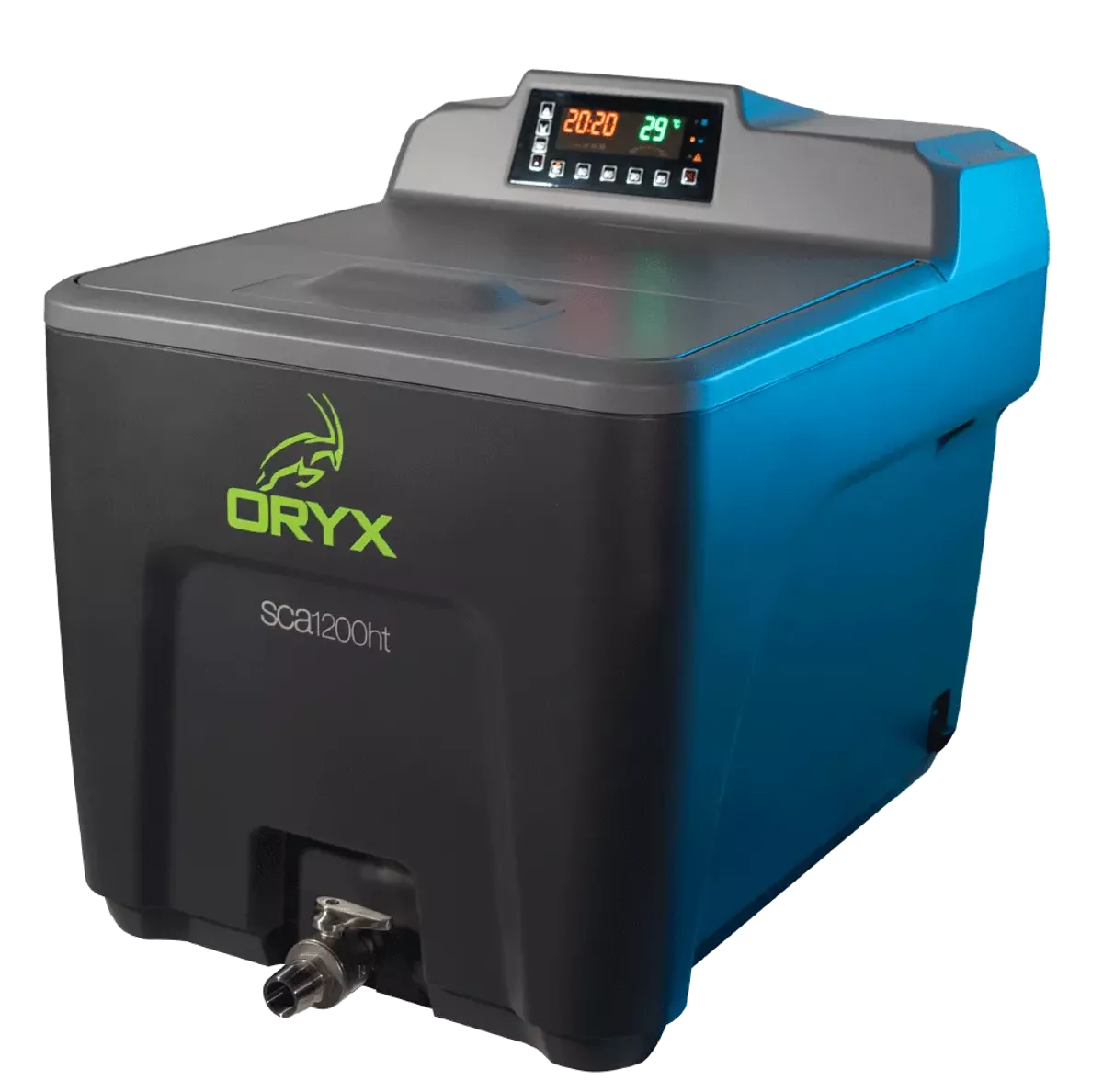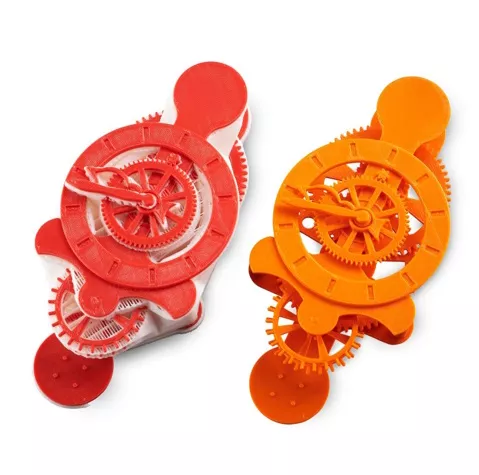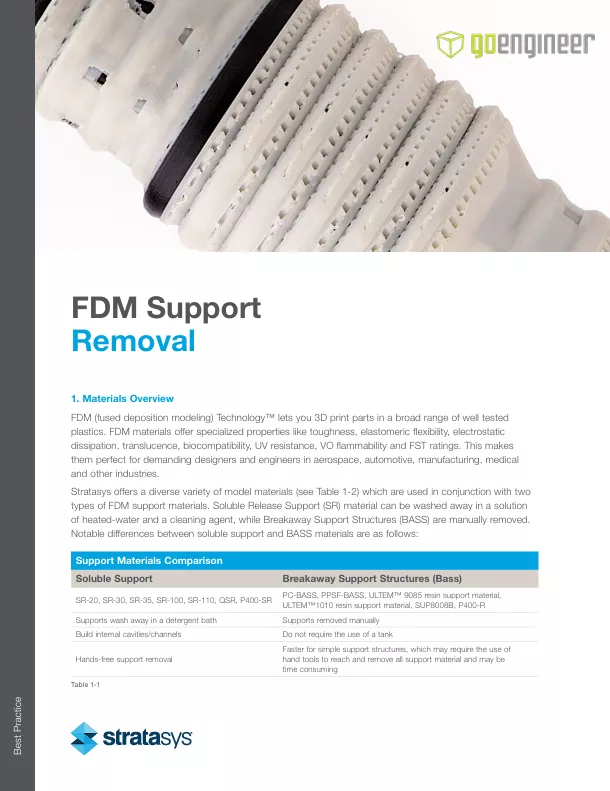FDM Post-Processing: Oryx sca1200ht for Soluble Support Removal
When running Stratasys FDM (Fused Deposition Modeling) 3D printers — especially in professional industrial environments — efficient post-processing is essential for achieving clean, accurate, and repeatable parts. One of the greatest advantages of Stratasys 3D printers is their ability to print with Soluble Support materials such as SR-30, SR-35, SR-100, SR-110, and QSR, allowing for a hands-free cleaning process. To this end, the Oryx sca1200ht is one of the simplest and most user-friendly tools available for FDM post-processing.
What is the Oryx sca1200ht?
The sca1200ht is a high-temperature washing station used mainly for removing the soluble supports from FDM 3D printed parts – most often on materials like ASA, ABS, PC, and Nylon. It is a very user-friendly system with one-push temperature settings and programable wash time settings. Simply fill the container with tap water and mix in the solution appropriate for the support material you are working with to dissolve it.

Technical Specifications
| Feature | Specification |
| Model | sca1200ht |
| Tank Capacity |
12.2 gallons (46.2 liters) |
| Temperature Range |
Ambient up to 85°C (185°F) |
| Tank Material | Stainless Steel |
| Compatible Support | SR-30, SR-100, QSR, and similar soluble supports |
| Dimensions (External) | Approx. 26.0Lx17.5Wx20.5Hin.(66.0Lx44.5Wx52.0Hcm) |
| Electrical Requirements |
110V standard; 220V optional |
| Agitation System |
Jetting/circulation system for uniform cleaning |
| Heating System |
Built-in heater with thermostat and safety shut-off |
Compatible Support Materials
The sca1200ht is designed and built to work with multiple support materials, including:
- QSR – from the Stratasys F123 Series level 3D printers
- SR-30 – used with ABS, ASA, and similar materials
- SR-35 – a more brittle and faster cleaning version of SR-30
- SR-100 – used with PC as an alternative to break-away support
- SR-110 – used with Nylons and PC-ABS
These support structures dissolve away in a detergent designed to effectively remove the supports without harming the printed parts.


The Cleaning Process: How Long Does It Take?
Several factors influence the time it takes to remove the support material. Here are some tips that can help optimize the cleaning process.
- Keep the cleaning solution fresh, following the best practices recommended for the specific material.
- Don't mix support materials in the same bath. (Surprisingly, cleaning SR-30 and SR-100 parts in the same bath slows down the process.)
- Do not overfill the tank with parts. Better circulation results in faster support removal.
Cleaning Time Depends on Several Variables:
- Type of support material
- Model geometry (tight/deep spaces)
- Support amount and density
- Solution saturation (how much has it already been used)
Typical Cleaning Times
- QSR: 2-4 hours
- SR-30/35: 4-8 hours
- SR-100/110: 6-12 hours
Chemical Solutions Used
The sca1200ht can use a variety of detergents depending on the support material being removed, including Stratasys WaterWorks (bottles premeasured for this tank, fast-acting strong alkaline solution suitable for all support materials) and Stratasys EcoWorks (slower, intended for SR-30, SR-35, and QSR).

FDM SUpport Removal Best Practices
Stratasys offers a diverse variety of model materials which are used in conjunction with two types of FDM support materials. Soluble Release Support (SR) material can be washed away in a solution of heated water and in a cleaning agent, while Breakaway Support Structures (BASS) are manually removed.
Get the complete breakdown of FDM support removal best practices in this guide.
Proper Disposal of Used Fluid
Always follow local waste disposal guidelines and regulations.
Support removal detergents are composed of alkaline chemicals (including sodium hydroxide, potassium hydroxide, sodium percarbonate, and others), along with surfactants and adjuvants (soaps).
A common practice is to run fresh water down the drain while draining the tank down the sink. Waste detergents typically have a pH greater than 9, which may be too basic to go down some drains. Neutralizing agents, like muriatic acid (HCl) or concentrated acetic acid (vinegar), can be used to bring the pH down to acceptable levels (e.g., 7) and pull the dissolved solids out of solution.
Some municipalities may require this to be collected and disposed of by a licensed waste disposal company. It is the users' responsibility to understand and follow local waste disposal guidelines. If you're unsure where to start, your local fire marshall or drain commissioner should be able to assist.
Use and Care
Always review and follow the use and care instructions included.
Environment
Place the sca1200ht on a sturdy countertop, ideally near a sink to avoid draining and filling with buckets, and close to a power supply. The room should also be climate-controlled and well-ventilated.
A sturdy and durable rolling cart can also be used to wheel your machine to and from a water source.
Day-to-Day Care
- Check the water level. A sensor will prevent it from running if levels are not within the proper minimum/maximum range.
- Keep it clean both inside and outside.
- Thoroughly rinse out the inside when changing the fluid. Check for small pieces and remove them.
How Do You Know When to Change the Solution?
Cleaning solutions become ineffective when the pH level drops too low. At this point, the liquid may develop a thicker texture and often emit an odor. However, the most obvious sign that it’s time to drain and refill the tank is when it takes longer than usual to clean the parts.
Safety Note
When filling the tank, always add the water first. After adding the water, turn on the circulation and gradually sprinkle the powder in to ensure proper mixing. Lastly, always use eye protection, and it is highly recommended to wear a mask and gloves, especially when handling the powder.
Why Choose the sca1200ht?
The sca1200ht stands out as a support cleaning tool because it:
- Can handle a range of temperatures and support materials
- Is easy to operate with minimal training
- Has a small footprint
- Is quiet while operating
- Is a long-term low-maintenance option
- Works seamlessly with the Stratasys 3D printers
Final Thoughts
Post-processing has traditionally been time-consuming and tedious, but the Oryx sca1200ht simplifies this task. It is easy to use, long-lasting, and most importantly, it gets the job done with minimal hands-on effort.
If you have questions or would like to learn more about the sca1200ht for soluble support removal, please contact us.
Related Articles
GrabCAD Streamline Pro Software for Stratasys 3D Printer Fleet Management
How 3D Printing is Helping Manufacturers Fight Back Against Tariffs
NASCAR Names Stratasys as Official 3D Printing Partner
Which Technology is Best for 3D Printing Miniatures?

About Joseph Miller
Joseph Miller is a 3D Printer Technical Support Specialist based out of Atlanta, Georgia. He earned his Bachelor’s degree from Brigham Young University in 2008 and a Master’s degree from Capella University in 2013. Joseph has been working in the Additive Manufacturing industry for over 12 years and has been part of the GoEngineer family since 2019.
Get our wide array of technical resources delivered right to your inbox.
Unsubscribe at any time.